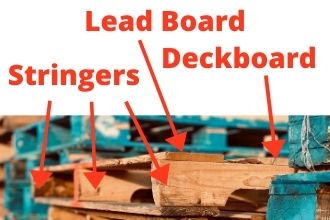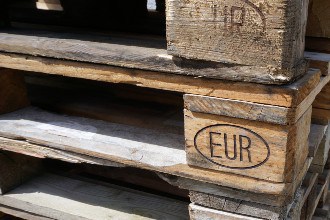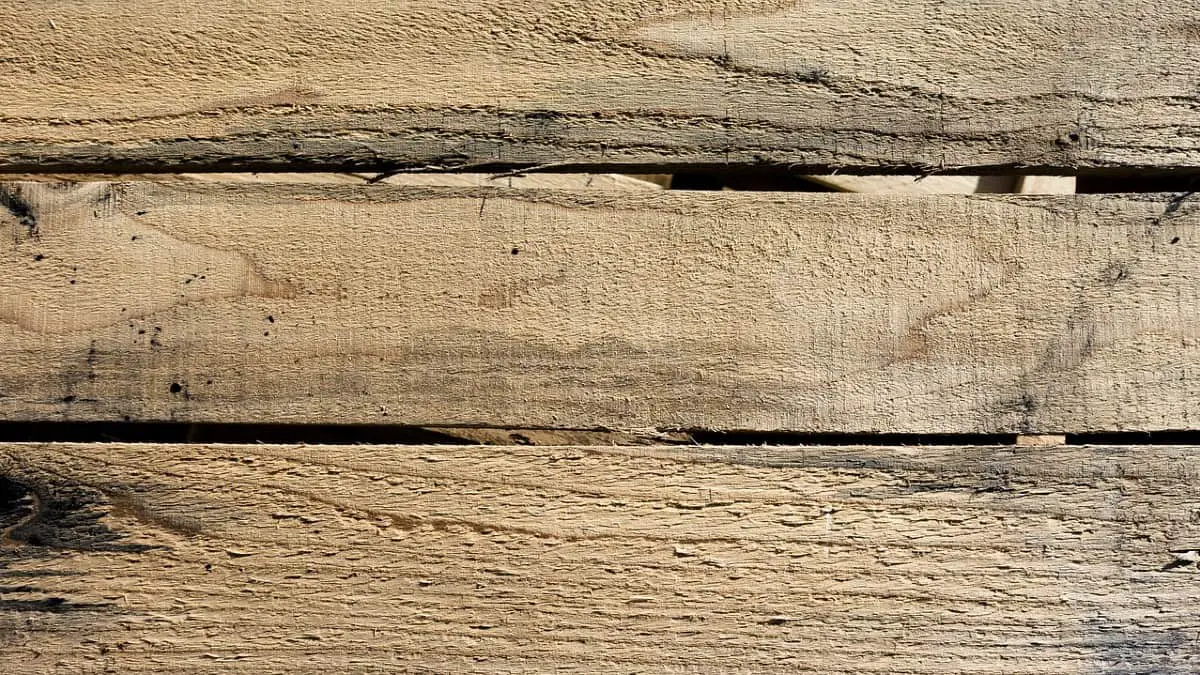Woodworking projects often make use of pallets. The rustic and weathered boards make them good sources of reclaimed wood. You can help the environment, and even save money, by choosing pallet wood for your next project.
However, I’ve often wondered if pallets could give me enough wood for my project. So, how much wood should can you get from a pallet?
How much wood can you get from a pallet? Approximately 10.11 board feet. This figure is approximate since not all pallets are the same: They come in different sizes and there are many pallet types. You can often extract expensive and durable hardwood from a wooden pallet. Let’s look into these issues and find out more.
Note: Some of the links below can be affiliate links. For more information, see the disclosure page.
Are All Pallets The Same?
No, they’re not. Clearly, the amount of wood you can get from a pallet depends on its individual size and type.The International Organization for Standardization (ISO) has defined several types of pallets in ISO Standard 6780. Some of these types are listed below:
- 48 inch x 40 inch – These are commonly found in North America. Many of them follow the standard set by the Grocery Manufacturers Association (GMA). The GMA is a trade association for food companies and similar organizations.
- 39.37 inch x 47.24 inch – These are commonly found in Asia and Europe. They are similar to the GMA pallets. In metric units, they’re 1000mm x 1200mm.
- 31.50 inch x 47.24 inch – These pallets are commonly found in Europe. They’re smaller, and fit into doorways more easily. In metric units, they’re 800mm x 1200mm.
Parts Of A GMA Pallet
Most GMA pallets contain the boards shown below:

Here is a description of these parts:
- Stringers – There may be about 3 stringers and they’re placed along the longer side of the pallet. These pieces are 48 inches in length. Also, they’re about 1 ½ inches thick by about 3 ½ inches wide.
- Lead Boards – These Planks are on the top and bottom of the palette at two opposing ends. The pieces help to strengthen the pallet. They’re usually about 6 inches wide and 5/16 inch thick.
- Deckboards – Like the lead boards, these are perpendicular to the stringers. They’re put between the lead boards, on the inner part of the pallet. The width can vary and be about 4 inches on average.
Let’s assume that you can take the pallet apart without destroying any of the boards. How much wood can you reclaim? The total amount of wood you can get is equal to the sum of the sizes of the pieces. How much wood is that?
How Much Wood You Can Get From A Pallet
We’re used to measuring the length, width, and thickness of the boards. Is this the best way to measure how much wood you can get from a pallet? No, it isn’t! It makes more sense to think in terms of board feet.
A board foot isn’t a unit of length. Instead, it’s a unit of volume: One board foot is equal to the volume taken up by a board 1 foot long, 1 foot wide, and 1 inch thick. This is equal to 144 cubic inches.
You may need to use board feet when you purchase wood. I wrote an article about this.
Example Pallet Calculation
How much wood can you get from a typical pallet? Is it possible to calculate the amount? How is this done?
Keep in mind that this is only an approximation. There are many variables: wood thickness, size and number of lead boards, size and number of deck boards, and even shapes of the stringers. These can alter the total number of board feet of wood you can get from the pallet.
So, let’s consider an ordinary 48 inch x 40 inch GMA pallet. In this example, assume there are three stringers, four lead boards, five deck boards on the top of the pallet, and three deck boards on the bottom. When you use the dimensions listed above, you come up with these figures:
- Each stringer is approximately 1.75 board feet of wood
- Every lead board is approximately .521 board feet of wood
- A deck board is approximately .347 board feet of wood
So, the total amount of wood you could get from this pallet equals 10.11 board feet.
How Much Wood Can You Get From A 4-Way Pallet?
A 2-way pallet only has openings on two opposite ends. So, the forks of a forklift can only enter on two sides. The example we have been looking at is of a 2-way pallet.

The 4-way pallet has openings or notches in the stringers. These allow the forks in the forklift to enter the pallet from any of the 4 sides.
So, why is this important? What does it have to do with the amount of wood you can get from a pallet?
These notches reduce the total volume of the pallet wood by a small amount. So, the total number of board feet is less. For a GMA pallet with 4 notches, this would amount to a reduction of about .401 board feet.
Also, these notches alter the shape of the stringer. So, you might not be able to use the entire 1 ½ inch thick by 3 ½ inch wide by 48 inch long piece of wood. It really depends on your project needs and what you’re trying to make.
The table below shows how much wood can be obtained from several pallet types. Calculations similar to the ones above have been used to determine these amounts:
| Type | Size | Board Feet |
|---|---|---|
| 2-Way | 48 inch x 40 inch | Approx. 10.11 |
| 4-Way | 48 inch x 40 inch | Approx. 9.71 |
| European | 39.37 inch x 47.24 inch | Approx. 23.07 |
| European – Made for doorway | 31.50 inch x 47.24 inch | Approx. 19.17 |
How To Get More Wood From A Pallet

It’s often very difficult to extract wood from a pallet. As you pry boards loose, you can put cracks in them. You might not be able to use these boards in your project. Also, they can break into smaller pieces. Again, you might not be able to use the results.
The pallet boards are held together by nails or other fasteners. When you attempt to take them apart, you might leave holes or marks in the wood. Some people use a jigsaw or some similar tool to cut away the nailed sections of the boards.
This approach can make removal easier. However, you waste a lot of the wood. How can you remove the most wood from the pallet? Can you extract boards without cracking them?
Yes! You can do this with a Pallet Buster / Pallet Breaker. This tool is similar in appearance to a “crowbar”. However, the end contains articulated flanges that move to maintain constant contact with the board as you pry it up.
This video shows a Pallet Buster / Pallet Breaker in action.
See a Pallet Buster / Pallet Breaker on Amazon.
Types Of Wood You Can Get From A Pallet
We know that it’s possible to obtain reclaimed wood from the pallet. However, the process is often difficult and inconvenient. It can require the use of special tools, be prone to waste, and consume time.
If a pallet is made of a commonly available wood such as Pine, it often makes more sense to just buy the wood at the lumber yard. This can be an economical way of dealing with the problem.
Pallet Wood Comparison
Often, the choice depends on the cost of the wood. Pine, for example, is much less expensive than Oak. In North America, pallets made with Pine or Oak are common. The table below lists some woods used for pallets and gives several properties for them:
| Name | Type | Stress (psi) | Side Hardness (lbf) |
|---|---|---|---|
| Pine | Softwood | 900 | 380 |
| Oak | Hardwood | 1,910 | 1,210 |
| Poplar | Hardwood | 1,190 | 540 |
| Fir | Softwood | 940 | 380 |
| Mahogany | Hardwood | 1,230 | 800 |
The fields in the table are defined like this:
- Name – This is the common name for the wood species.
- Type – This tells you if is a Hardwood or Softwood
- Stress – This tells you the stress the wood can withstand before breaking, in psi (pounds per square inch).
- Side Hardness – This tells you the amount of force required to push a steel ball .444 inches in diameter halfway into the wood. This tells you how resistant the wood is to denting and gives you a measure of the wood hardness. The force in this table is measured in Imperial lbf units.
So, in summary, you can get wood from a pallet. When you’re considering how much wood you can get from a pallet, you need to ask: Does it even make sense to obtain wood from the pallet? At times, you can extract beautiful and expensive hardwood.
How Many Boards Are In A Pallet?
The earlier pallet example had 4 lead boards, 5 deckboards on top, and three on the bottom.
Some have more deck boards or no lead boards. In addition, the width of the boards can differ. Pallets have many types and come in all sorts of sizes.
These factors affect the amount of wood you can get from the pallet. It makes sense that you should be able to get more board feet with extra boards or wider ones.
Conclusion
Many of the projects built today use wood obtained from pallets. These include bookcases, shelves, wall decor, and even boxes for the garden! Pallets are used because the’re a source of rustic and beautiful reclaimed wood. This wood has an attractive character. On top of that, it can be obtained for little to no cost. Also, in this age, people are eager to re-use and recycle. They like the fact that the’re able to use the wood in a pallet for new things.
There are many types of pallets. These have different designs and dimensions. So, the amount of wood you can get varies from one type of pallet to another. Many factors can affect the amount of wood you can extract: These include things like type pallet, the condition of the pallet, and also the technique used to remove the wood. If you don’t use the proper tools, you can end up by cracking wood and making it unusable.
You can get many types of wood from a pallet. Some of these are softwoods while others are hardwoods. The hardwords are usually more dense and expensive than softwoods. So, it might make more sense to get wood from a pallet if it contains hardwood rather than softwood.
Here is a link to an additional article I wrote about pallets: How To Clean Pallet Wood For Indoor Use.
Did you enjoy this post? Be sure to share. Also, don’t forget to follow my boards on Pinterest.

